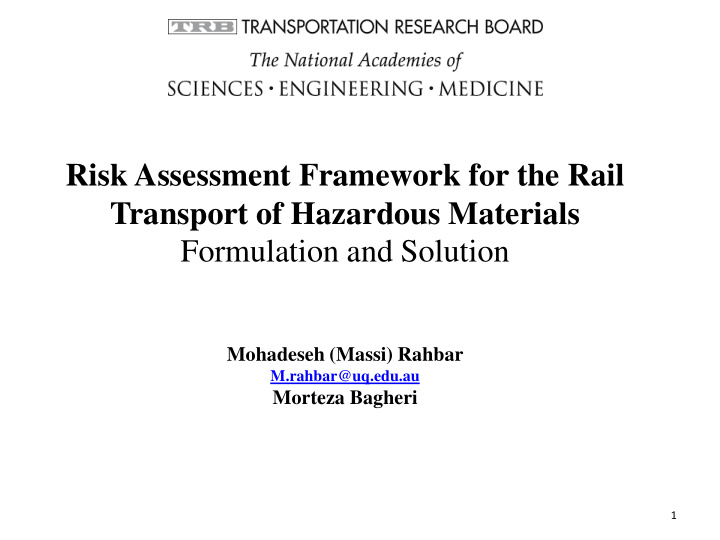



Risk Assessment Framework for the Rail Transport of Hazardous Materials Formulation and Solution Mohadeseh (Massi) Rahbar M.rahbar@uq.edu.au Morteza Bagheri 1
Outline • Introduction • Research Objectives • Proposed Model • Proposed Solution Method • Case Study • Conclusions & Recommendations 2
Introduction 144 1200 Rail Accident 104 Dangerous Goods Derailments Number of Rail Accidents, 2015 Transportation Safety Board of Canada 3
North Dakota December 30, 2013 4
Quebec, Canada July 6, 2013 5
Introduction • Ways of addressing this concern: 1. improvement of track infrastructure and rolling stocks 2. prevention of HAZMAT involvement cars in an accident 3. reducing the rate of HAZMAT release 4. reducing the severity of HAZMAT release 6
Research Objectives • Developing an integrated risk assessment framework • Applying the proposed model to a case study corridor • Comparing the case study findings to previous study results 7
Restrictions A B C D E F A 0 1 1 0 1 0 B 1 0 1 0 1 0 λ = C 1 1 0 0 1 0 D 0 0 0 0 1 0 E 1 1 1 1 0 0 F 0 0 0 0 0 0 The cars with non-HAZMAT The cars equipped with a source of ignition, a mechanical heating source or cooling device 8
Proposed Model • Objective function Minimizing the HAZMAT derailment risk • Constraints Guarantee that each car would be located in one position of its block Guarantee that each position of a block would be occupied by one car which belongs to this block 9
Proposed Model • Constraints Prevent locating any HAZMAT car next to operating engine Kept separate HAZMAT cars from one another and the cars which belong to group E, based on matrix λ. 10
Yard Operation Cost Constraint 11
Yard Operation Cost Constraint Guarantees that the rail yard train assembly costs for each HAZMAT placement strategy should be less than the maximum time which is announced by the yard master 12
The Proposed Solution Method 13
Case Study 14
Results of the Proposed Method Lable T max(min) OptimalObjectiveValue Time(s) NumberOfConstraint ( × 10 -6 ) (8) ‒ ‒ CKA 0 150 1390 220 1086 0 0 CKA 107 1086 2 11 600 1223 0 0 KCA 400 1223 120 396 610 1054 0 0 CAK 460 1054 40 206 830 1177 0 0 ACK 660 1177 540 1058 900 1091 0 0 KAC 660 1091 600 1086 800 1127 0 0 AKC 630 1127 1140 1526 15 ‒ =not applicable
The Best Results in the Literature T max (min) OptimalObjectiveValue ( × 10 -6 ) Time (s) Lable ‒ 142 1658 CKA 0 182 1106 788 CKA 225 1248 436 KCA 184 1082 524 CAK 195 1239 460 ACK 234 1122 866 KAC 227 1176 579 AKC ‒ =not applicable 16
Conclusions • Proposing a new closed-form mixed integer programming model with yard operation cost constraint • Proposing a two stage solution procedure 17
Recommendations • Considering consequence in the calculation of risk value • Combining routing problems with the proposed risk minimization model 18
Thank You 19
Recommend
More recommend